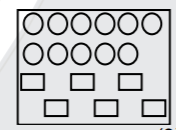At equilibrium, the value of equilibrium constant K is
1
2
3
0
The correct Answer is:A
To solve the question about the value of the equilibrium constant K at equilibrium, we can follow these steps:
1. Understand the Concept of Equilibrium:
At equilibrium, the system has reached a state where the concentrations of reactants and products remain constant over time. This is when the forward and reverse reactions occur at the same rate.
2. Recall the Relationship Between Gibbs Free Energy and Equilibrium Constant:
The relationship between Gibbs free energy (ΔG) and the equilibrium constant (K) is given by the equation:
ΔG=−nRTlnK
where:
- n = number of moles of the reaction,
- R = universal gas constant,
- T = temperature in Kelvin,
- K = equilibrium constant.
3. Set ΔG to Zero at Equilibrium:
At equilibrium, the change in Gibbs free energy (ΔG) is zero. Therefore, we can set up the equation:
0=−nRTlnK
4. Solve for K:
Since nRT is not zero (as long as the temperature is above absolute zero), we can divide both sides of the equation by −nRT:
0=lnK
This implies:
K=e0
Since e0=1, we find that:
K=1
5. Conclusion:
Thus, at equilibrium, the value of the equilibrium constant K is equal to 1.
Final Answer:
The value of the equilibrium constant K at equilibrium is 1.
---
At equilibrium, the system has reached a state where the concentrations of reactants and products remain constant over time. This is when the forward and reverse reactions occur at the same rate.
The relationship between Gibbs free energy (ΔG) and the equilibrium constant (K) is given by the equation:
ΔG=−nRTlnK
where:
- n = number of moles of the reaction,
- R = universal gas constant,
- T = temperature in Kelvin,
- K = equilibrium constant.
At equilibrium, the change in Gibbs free energy (ΔG) is zero. Therefore, we can set up the equation:
0=−nRTlnK
Since nRT is not zero (as long as the temperature is above absolute zero), we can divide both sides of the equation by −nRT:
0=lnK
This implies:
K=e0
Since e0=1, we find that:
K=1
Thus, at equilibrium, the value of the equilibrium constant K is equal to 1.
The value of the equilibrium constant K at equilibrium is 1.
Topper's Solved these Questions
- CHEMICAL EQUILIBRIUMBOOK - CENGAGE CHEMISTRY ENGLISHCHAPTER - CHEMICAL EQUILIBRIUMEXERCISE - Exercises (Fill In The Blanks)
35 Videos
- CHEMICAL EQUILIBRIUMBOOK - CENGAGE CHEMISTRY ENGLISHCHAPTER - CHEMICAL EQUILIBRIUMEXERCISE - Exercises (True/False)
30 Videos
- CHEMICAL EQUILIBRIUMBOOK - CENGAGE CHEMISTRY ENGLISHCHAPTER - CHEMICAL EQUILIBRIUMEXERCISE - Exercises (Assertion-Reasoning)
15 Videos
- CHEMICAL BONDING AND MOLECULAR STRUCTUREBOOK - CENGAGE CHEMISTRY ENGLISHCHAPTER - CHEMICAL BONDING AND MOLECULAR STRUCTUREEXERCISE - Archives Subjective
15 Videos
- CLASSIFICATION AND NOMENCLATURE OF ORGANIC COMPOUNDSBOOK - CENGAGE CHEMISTRY ENGLISHCHAPTER - CLASSIFICATION AND NOMENCLATURE OF ORGANIC COMPOUNDSEXERCISE - Analytical and Descriptive Type
3 Videos
Similar Questions
Unit of equilibrium constant is:
View SolutionIf degree of dissociation is 0.5 at equilibrium then the equilibrium constant Kc for the given reaction is , 2HI<⇒2=I2
View SolutionFor an equilibrium reaction, if the value of standard Gibb's free energy, AG° is zero, then the value of equilibrium constant, K will be equal to
View SolutionDetermine the values of equilibrium constant (KC)andΔGo for the following reaction :
View SolutionFor any reaction, greater the value of equilibrium constant greater is the extent of reaction.
View SolutionFor the reaction H2(g)+I2(g)⇔2HI(g) at 721 K the value of equilibrium constant (Kc) is 50. When the equilibrium concentration of both is 0.5 M, the value of Kp under the same condtions will be
View SolutionFor reaction : H2(h)+I2(g)⇔2HI(g) at certain temperature, the value of equilibrium constant is 50. If the volume of the vessel is reduced to half of its original volume, the value of new equilibrium constant will be
View SolutionReactant A represented by square is in equilibrium with product B represented by circles. Then value of equilibrium constant is

View SolutionReactant A represented by square is in equilibrium with product B represented by circles. Then value of equilibrium constant is

View Solution(i) List the applications of equilibrium constants.
(ii) Predict the extent of reaction when the value of equilibrium constant is very high.
View Solution
